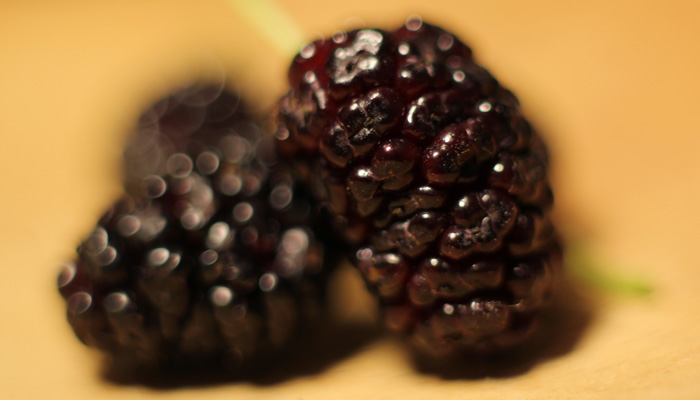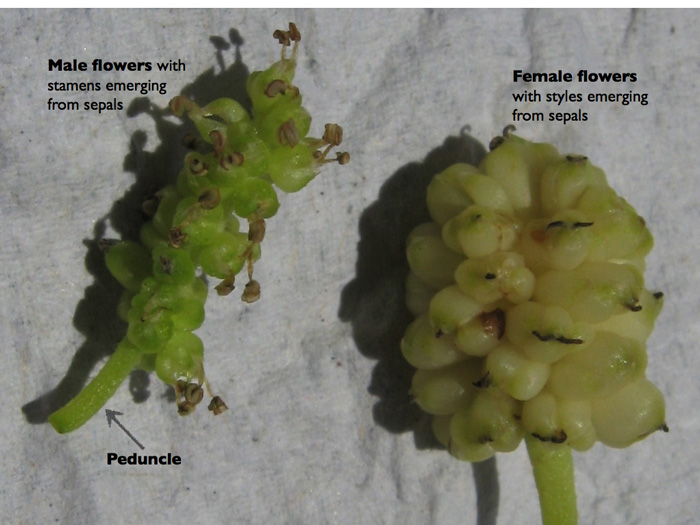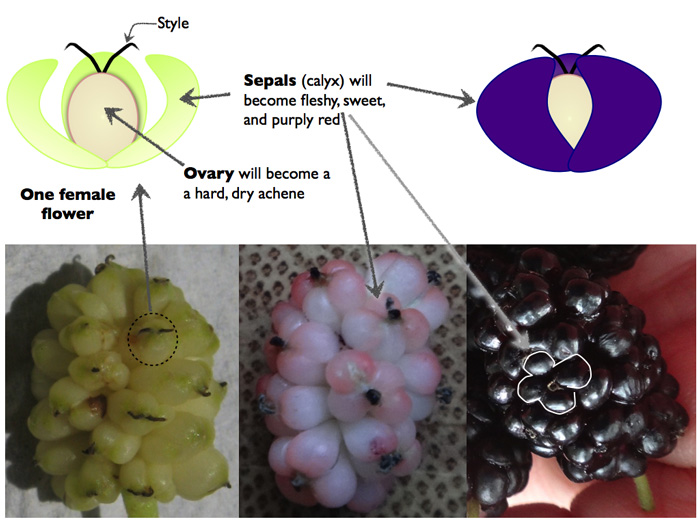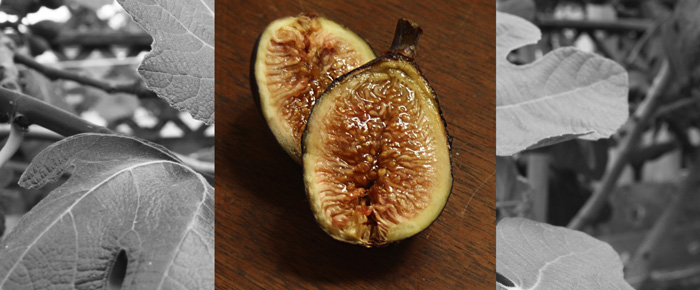Figs and Mulberries, Inside and Out
 Figs and mulberries are both gorgeous, sexy fruits, but in very different ways. At first blush a mulberry could be the hot-mess cousin of a blackberry, while figs are classically sensual fruits, like marble nudes teetering on the edge of vulgar. For all their fleshy assertiveness, both fruits keep their secrets; and it takes more than a long, intense gaze to uncover their close relationship and know their sweetest parts. Mulberries may look like blackberries (and share a taxonomic order), but they are built from different plant components. The true siblings are mulberries and figs (both in family Moraceae), and at heart they are very much alike, although figs are clearly the more introverted of the two.
Figs and mulberries are both gorgeous, sexy fruits, but in very different ways. At first blush a mulberry could be the hot-mess cousin of a blackberry, while figs are classically sensual fruits, like marble nudes teetering on the edge of vulgar. For all their fleshy assertiveness, both fruits keep their secrets; and it takes more than a long, intense gaze to uncover their close relationship and know their sweetest parts. Mulberries may look like blackberries (and share a taxonomic order), but they are built from different plant components. The true siblings are mulberries and figs (both in family Moraceae), and at heart they are very much alike, although figs are clearly the more introverted of the two.
Anatomy 101
To understand a mulberry or a fig, you first have to recall the basic structure of a flower and imagine the various ways flowers can be grouped on a plant. Both figs and mulberries cluster their tiny flowers together into dense and well-defined inflorescences. And, in both, all the flowers on an inflorescence then develop into a single fused unit, which we casually call a fruit. Before offering the details of what we eat, we’ll need to look at the individual flowers and fruit.
An idealized flower has four concentric rings of parts, or whorls. From the outside in, they are:
1) usually green, modified leaves, called sepals;
2) often colored or otherwise showy petals;
3) the “male†stamens, consisting of a filament holding aloft a pollen-filled anther; and
4) one or more “female†pistils, anchored by an ovary.
The pistil catches pollen grains, which then grow down through a style to the ovary and the seeds within. The ovary matures into a fruit.
But, not all flowers have all of these parts. Figs and mulberries make separate flowers with only one or the other sex, and both “male†and “female†flowers lack petals. Mulberry flowers are not large or showy, but they are visible. Fig flowers, by contrast, cannot be seen without opening up the structure that encloses them. Being hidden from view also means being hidden from all but the most specialized pollinators. Under a magnifying lens, mulberry and fig flowers are remarkably similar, however, their stories diverge as the flowers are pollinated and their fruits develop.
 Fruiting bodies
Fruiting bodies
Tiny mulberry flowers make miniscule fruits; by sticking together across the entire inflorescence they masquerade as one large fruit, and probably enhance their power to entice birds and improve their dispersal efficiency. But that’s not the mulberry’s only beauty secret. Strictly speaking, mulberry fruits are not attractive. As appealing as a grain of sand, they are hard, dry achenes, or one-seeded fruits, like those that speckle the strawberry. To make themselves sweet and juicy, they plump up the only other flower parts they have—their sepals.
 To understand the structure of figs we can start with the realization that the peduncle—the stalk that supports each flower cluster—is the delicious bulk of what we enjoy when we eat a fig. To begin, it is useful to reconstruct (approximately) evolution’s recipe for figs. Imagine a mulberry inflorescence, give it a long peduncle, and mentally expand the entire axis into a globe. All of the flowers should be above the equator, with the peduncle below it. Pull outwards on the equator, flattening the globe into a disk with all the flowers on top and the peduncle constituting the underside. Finally, curve the disk upwards into a bowl, then into an urn, and finally into a sack. All the flowers will be inside the sack, completely surrounded by peduncle tissue. The entire structure has a specialized name: syconium.
To understand the structure of figs we can start with the realization that the peduncle—the stalk that supports each flower cluster—is the delicious bulk of what we enjoy when we eat a fig. To begin, it is useful to reconstruct (approximately) evolution’s recipe for figs. Imagine a mulberry inflorescence, give it a long peduncle, and mentally expand the entire axis into a globe. All of the flowers should be above the equator, with the peduncle below it. Pull outwards on the equator, flattening the globe into a disk with all the flowers on top and the peduncle constituting the underside. Finally, curve the disk upwards into a bowl, then into an urn, and finally into a sack. All the flowers will be inside the sack, completely surrounded by peduncle tissue. The entire structure has a specialized name: syconium.
Fig flowers are even smaller than mulberry flowers and likewise make gritty little achenes for fruit. They are attached to the inside of the syconium by flower stalks, which get very soft as figs ripen. The sweet part of the fig is a combination of peduncle, flower stalks, and sepals.
 A pollinator’s peak performance
A pollinator’s peak performance
Before the fruit can ripen, the flowers must be pollinated. Mulberries are simply wind- pollinated. However, in most of the more than 800+ fig species, pollination is courtesy of small wasps from the Agaonidae family. Figs and agaonid wasps have required one another for existence for at least 60 million years. And like many co-dependencies, this one isn’t pretty. Fig seeds feed wasp larvae. New wasps synchronously emerge from the seeds within a syconium. The wingless, blind males have two quick duties before dying: inseminating their sisters and chewing escape holes for them. Before leaving home, females gather pollen from male flowers. A winged female has 48 hours to find and enter a new receptive fig, pollinate the flowers, and lay eggs. The fig doesn’t help her. The only opening, the narrow ostiole, is defended with sharp bracts. With specialized jaws and a strong head, she chews her way past this gauntlet and into the fig, but tears her wings and antennae in the process.
Figs make two kinds of female flowers: long-styled and short-styled. Wasps can only lay eggs in short-styled flowers. The short-styled flowers thus make wasps, whereas the long-styled flowers make fertile seeds. The female wasp dies after her tasks are complete and fig enzymes devour her body during ripening. Some mutant varieties of the common fig can ripen syconia without pollination. These have been asexually propagated by humans for over 11,000 years and comprise most of our edible figs. Some favored varieties (e.g. Calimyrna) still require wasp pollination to develop, but their long-styled flowers preclude egg-laying, and we avoid a mouthful of baby wasps. While perhaps small comfort to the squeamish, the rest of us fig and mulberry enthusiasts can toast the wasps and the wind.

Acknowledgement: Thanks to Quentin Cronk for correspondence about the morphological delimitation of peduncles.
Image credits: Katherine A. Preston and Jeanne L. D. Osnas, illustrations. Barbara Ozimec, top and bottom photos.

